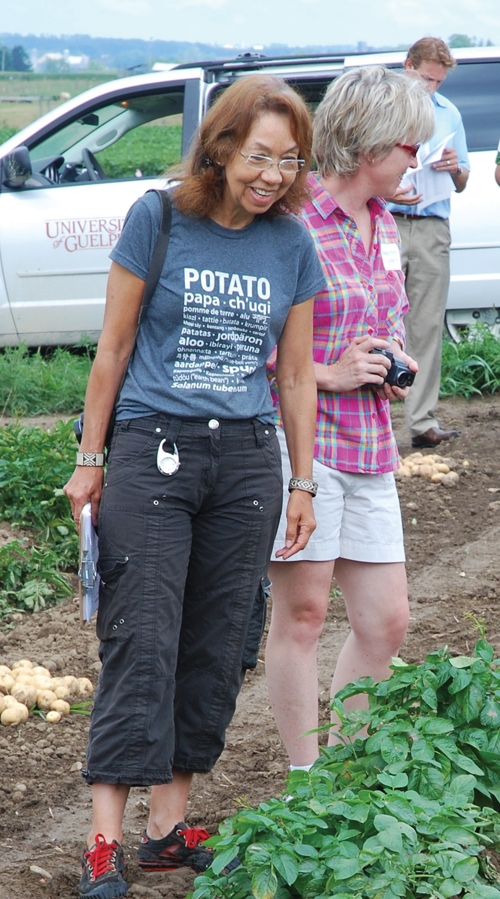
Features
Agronomy
Crop Protection
Nipping late blight in the bud
Late blight (Phytophthora infestans) was highly prevalent in the potato crop in 2009. “The growing season in Ontario was cool and wet, creating ideal conditions for the potato crop, and also for the fungus,” says Dr. Eugenia Banks, potato specialist for the Ontario Ministry of Agriculture, Food and Rural Affairs.
June 18, 2013 By Katerina Maevska
 Late blight is a devastating disease with the potential to destroy a field in just five to seven days Late blight (Phytophthora infestans) was highly prevalent in the potato crop in 2009. “The growing season in Ontario was cool and wet
Late blight is a devastating disease with the potential to destroy a field in just five to seven days Late blight (Phytophthora infestans) was highly prevalent in the potato crop in 2009. “The growing season in Ontario was cool and wetLate blight also surfaced earlier than usual, with the first outbreaks detected in Ontario and the Maritimes in early July. “The very wet weather was an important factor that contributed to early infection,” says Dr. Zenaida Ganga, a research scientist with Cavendish Farms based in New Annan, Prince Edward Island.
Acting quickly with effective fungicides is crucial in controlling fungal outbreaks. “Late blight has always been a devastating disease that can destroy a potato field in five to seven days if no effective fungicides are applied,” says Banks. “In 2009, Ontario growers started spraying early to keep the lower part of the plants protected, and this strategy paid off.”
There are, however, a number of factors complicating current control of late blight. “This pathogen is always evolving and more aggressive strains appear from time to time, making control more difficult,” says Banks.
The use of resistant varieties along with the proper use of fungicides makes an effective IPM program.
Mechanisms that allow survival between growing seasons may also play a role in outbreaks being observed shortly after crop emergence. Although bittersweet climbing nightshade is not especially prevalent in PEI or Ontario, Banks says the probability exists that late blight survives the winter in the perennial weed, which is found in the same botanical family (Solanacea) as potatoes.
Careful inspection and grading-out of infected seed is also paramount in preventing early outbreaks of the pathogen. “The frequency of late blight transmission by means of contaminated seed tubers is underestimated,” says Ganga.
“A circle of infected plants with a few dead plants in the centre suggested that the disease originated from infected seed in 2009 here in Ontario,” says Banks. “Growers are quite aware of the threat of infected seed, because not all infected seed tubers rot in the soil after planting. The infected plants that emerge can produce millions of late blight spores under favourable weather conditions and start an epidemic.”
Control in 2010
Banks says that widespread late blight presence in seed production areas in 2009 makes it highly probable that seed will be infected in 2010. She recommends growers follow several steps to reduce the risk of early season late blight outbreaks. “Grade seed lots very carefully to destroy suspicious tubers before planting,” she says. “Growers should also use a seed treatment that contains mancozeb, and make sure cull piles are eliminated before crop emergence.”
Even one grower not properly managing their cull pile can cause widespread infections over large areas of cultivation, according to Brian Beaton, potato co-ordinator with the PEI Department of Agriculture in Charlottetown. “We had a number of cases of late blight in 2009, and that followed a bad season in 2008,” he says. “The spores can overwinter in tubers.”
Beaton advises disposing of cull piles, especially ones with diseased tubers, as soon as possible. “We’re really trying to minimize what could be out there this June, and everyone must do their part,” he says. He also cautions growers to watch
for volunteer potato plants in their other crops.
Once growers have graded, disposed of cull piles, applied a seed treatment and planted, Banks says they should begin scouting fields as soon as the crop emerges. Stem lesions appearing early in the growing season are difficult to detect, but dangerous because of their ability to produce abundant inoculum over extended periods of time.
Banks recommends following a preventive fungicide program that puts emphasis on crop growth and weather conditions. Ganga agrees that it’s best to protect the plant before late-blight infection occurs.
“Apply Curzate when emergence is about 80 percent if the risk of late blight is high, as it will be in 2010,” says Banks. DuPont Curzate fungicide should be applied at 225 grams per hectare with Manzate Pro-stick fungicide at 1.35 kg to 1.6 kg per hectare (using a higher rate for higher expected pressures). Do not use Curzate alone.
When late blight is found, Banks recommends two applications of Curzate plus a protectant fungicide back to back, “because Curzate has a kickback effect shown to reduce disease incidence. The first spray should be applied as soon as late blight is found, followed by a second application four days later.”
“Spraying new fungicides such as phosphorous acid in combination with a protectant fungicide could also give a protection to the crop’s foliage and the tubers before storage,” adds Ganga.
Although time consuming, diligent management of late blight is the best course of action. “Growers should strive to have new growth protected at all times,” says Banks. n
Print this page